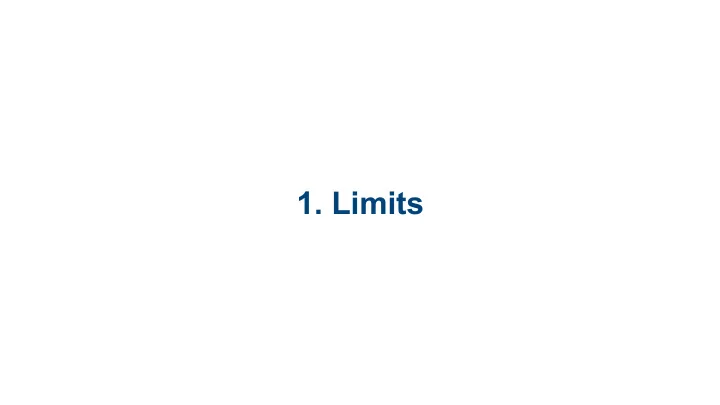

1. Limits
1.1 Definition of a Limit 1.2 Computing Basic Limits 1.3 Continuity 1.4 Squeeze Theorem
1.1 Definition of a Limit
• The limit is the central object of calculus. • It is a tool from which other fundamental definitions develop. • The key difference between calculus and everything before is this idea. • We say things like: a function f ( x ) has a limit at a point y
x → y f ( x ) = L if, for all ✏ > 0 , there exists some � > 0 lim such that if 0 < | x − y | < � , then | f ( x ) − L | < ✏ . • In other words, if a point is close to , y x then the outpoint is close to . f ( x ) L
• The limit definition does not say needs to exist! f ( x ) • The special case when f ( x ) y → x f ( y ) lim exists and is equal to is special, and will be discussed later.
• One can sometimes visually check if a limit exists, but the definition is very important too. • It’s a tough one the first time, but is a thing of great beauty.
1.2 Computing Basic Limits
• Computing limits can be easy or hard. • A limit captures what the function looks like around a certain point , rather than at a certain point.
• To compute limits, you need to ignore the function’s value, and only analyze what happens nearby. • This is what the ✏ − � definition attempts to characterize.
x → 0 ( x + 1) 2 Compute lim
x 2 + 2 x + 1 Compute lim x + 1 x →− 1
x 2 + 2 x + 1 Compute lim x + 1 x → 1
1 Compute lim x → 0 x
√ ! x 4 + x 2 Compute lim x → 0 x
1.3 Continuity
• Sometimes, plugging into a function is the same as evaluating a limit. But not always! • Continuity captures this property. f is continuous at x if y → x f ( y ) = f ( x ) lim
• Intuitively, a function that is continuous at every point can be drawn without lifting the pen.
f is continuous if it is continuous at x for all x
( 1 if x 6 = 0 Discuss the continuity of f ( x ) = x 0 if x = 0
( 2 x + 1 if x ≤ 1 Discuss the continuity of f ( x ) = 3 x 2 if x > 1
• Polynomials, exponential functions, and are sin , cos continuous functions. • Rational functions are continuous except at points where the denominator is 0. • Logarithm is continuous, because its domain is only . (0 , ∞ )
1.4 Squeeze Theorem
• There are no one-size- fits-all methods for computing limits. • One technique that is useful for certain problems is to relate one limit to another. • A foundational technique for this is based around the S queeze Theorem.
Squeeze Theorem Suppose g ( x ) ≤ f ( x ) ≤ h ( x ) for some interval containing y. ⇒ lim x → y g ( x ) ≤ lim x → y f ( x ) ≤ lim x → y h ( x )
• We will not prove this (or any, really) theorem. • One classic application of the theorem is computing sin( x ) lim x → 0 x
• Direct substitution (which one should be very wary of when computing limits) fails. • Indeed, plugging in x = 0 yields sin(0) = 0 0 = DNE 0
• An instructive exercise is to show that, for cos( x ) ≤ sin( x ) ≤ 1 x sin( x ) ⇒ lim x → 0 cos( x ) ≤ lim ≤ lim x → 0 1 x → 0 x sin( x ) ⇒ 1 ≤ lim ≤ 1 x → 0 x sin( x ) ⇒ lim = 1 x → 0 x
Recommend
More recommend